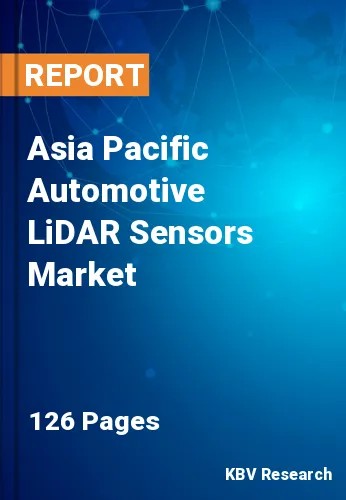The Asia Pacific Automotive LiDAR Sensors Market would witness market growth of 32.7% CAGR during the forecast period (2023-2029).
Several different manufacturers of LiDAR sensors are hard at work developing low-cost sensors. It is anticipated that in the coming years, the price of high-quality LiDAR sensors will decrease due to comparable advances. Venture capitalists are showing interest in businesses that are working to produce autonomous car LiDAR sensors that are more affordable. During the period that is being anticipated, a trend toward lower prices is likely to be one of the most important growth factors for the market.
The integration of LiDAR sensors into vehicles has led to the emergence of various novel applications and domains that could incorporate LiDAR technology. LiDAR technology has various applications in the business, including its use in robo-taxis for ride-sharing services, on-demand car services, shuttle services, and mobility-on-demand (MOD) fleets, in addition to its use in automobiles for ADAS. The exceptional capabilities of LiDAR sensors have garnered significant investments from automotive OEMs globally, with the goal of facilitating their integration and advancement in upcoming self-driving vehicles.
The fatality rate from traffic accidents in regional Australia is significantly higher than that of urban areas, with a rate of 9.6 per 100,000 compared to the average of 2.2 per 100,000. The prevalence of high-speed motorways in rural areas significantly contributes to the increase in fatality rates. This is due to a higher incidence of accidents in areas with faster speeds. In addition, single-lane carriageways are a common sight on highways in rural and remote areas. The roads in question are characterized by substandard surface quality, construction, and increased roadside hazards. Also, the implementation of strict road safety laws by regional governments in APAC will drive the market's utilization and growth.
The China market dominated the Asia Pacific Automotive LiDAR Sensors Market by Country 2022, and would continue to be a dominant market till 2029; thereby, achieving a market value of $485.3 Million by 2029. The Japan market us estimated to grow a CAGR of 31.9% during (2023 - 2029). Additionally, The India market would display a CAGR of 33.6% during (2023 - 2029).
Based on Type, the market is segmented into Time of Flight (ToF), and Frequency-Modulated-Continuous-Wave (FMCW). Based on Technology, the market is segmented into Solid-state, and Electro-mechanical. Based on Vehicle Type, the market is segmented into Internal Combustion Engine (ICE), Hybrid, and Battery Electric. Based on Image Type, the market is segmented into 2 Dimensional, and 3 Dimensional. Based on Application, the market is segmented into Semi-autonomous Vehicles, and Autonomous Vehicles. Based on countries, the market is segmented into China, Japan, India, South Korea, Singapore, Malaysia, and Rest of Asia Pacific.
Free Valuable Insights: The Worldwide Automotive LiDAR Sensors Market is Projected to reach USD 5.3 Billion by 2029, at a CAGR of 32.1%
The market research report covers the analysis of key stake holders of the market. Key companies profiled in the report include Robert Bosch GmbH, Continental AG, Denso Corporation, Ouster, Inc., HELLA GmbH & Co. KGaA, First Sensor AG (TE Connectivity Ltd.), Texas Instruments, Inc., KUBOTA Corporation, Quanergy Systems, Inc. and LeddarTech Inc.
By Type
By Technology
By Vehicle Type
By Image Type
By Application
By Country
Our team of dedicated experts can provide you with attractive expansion opportunities for your business.

